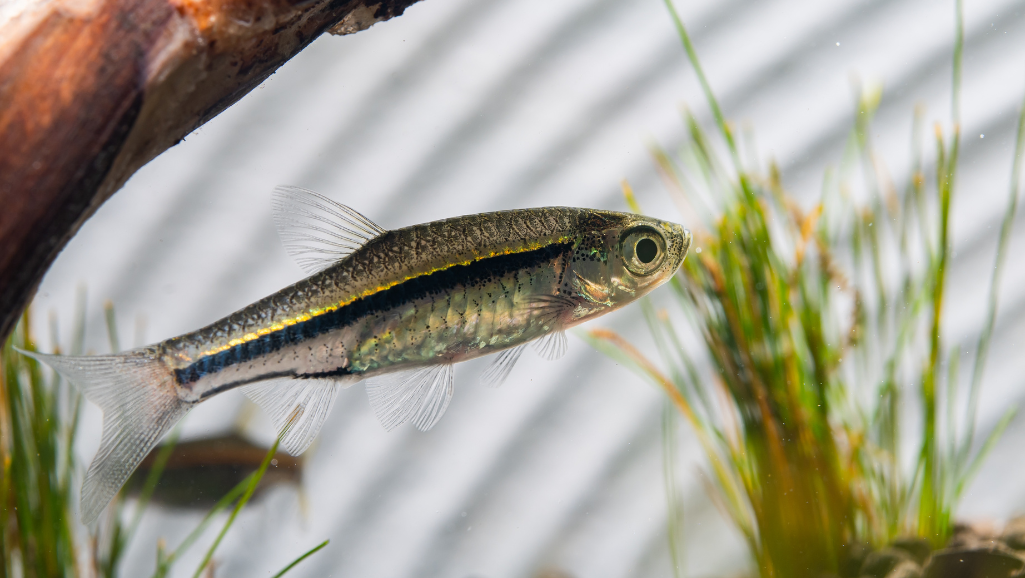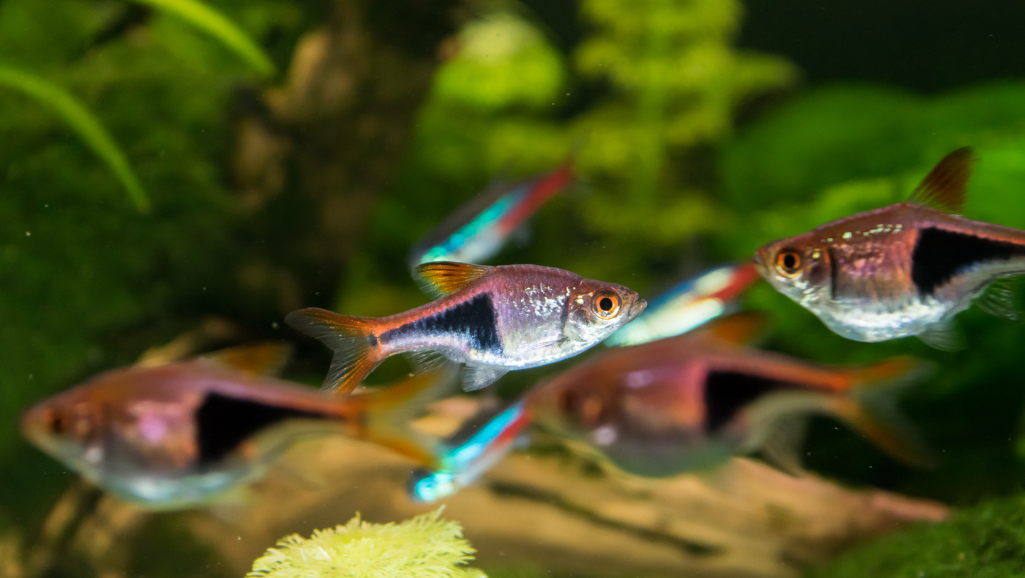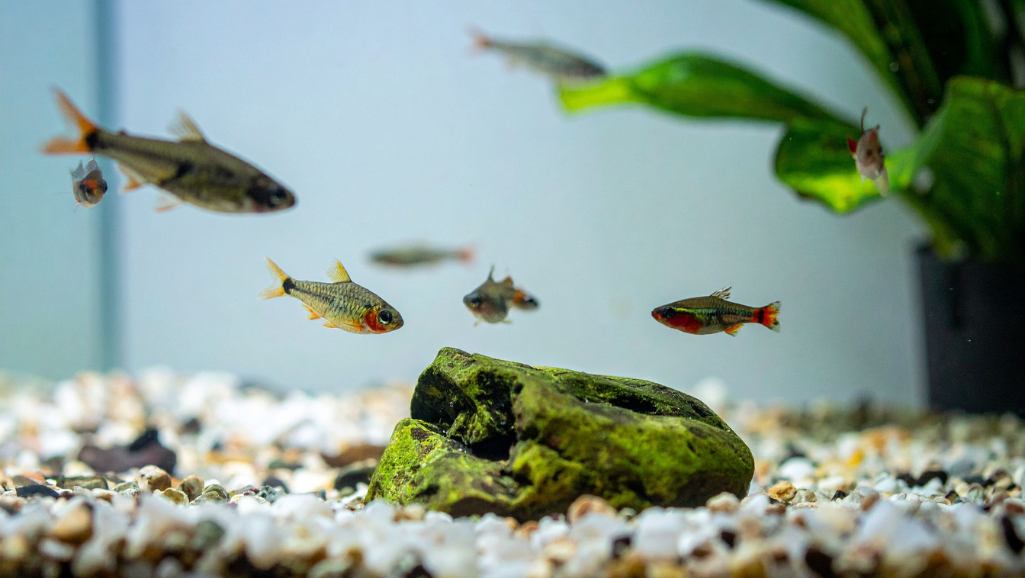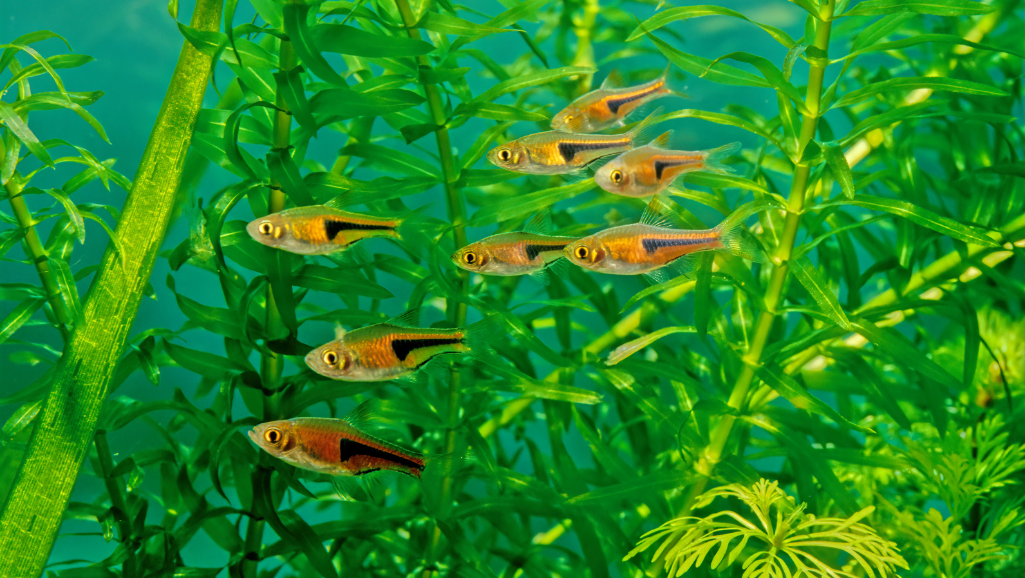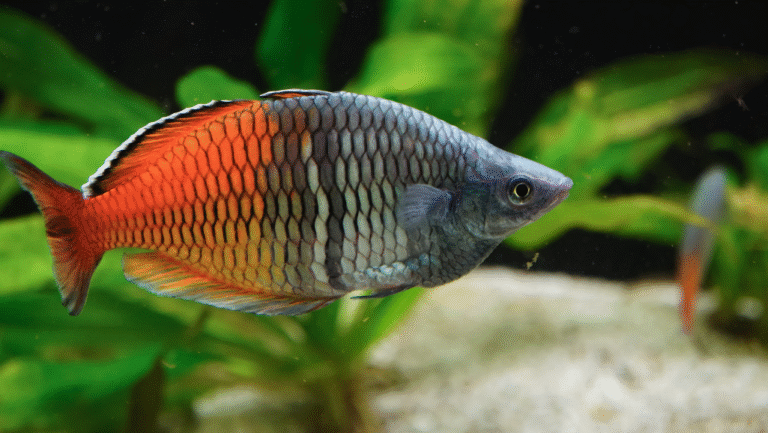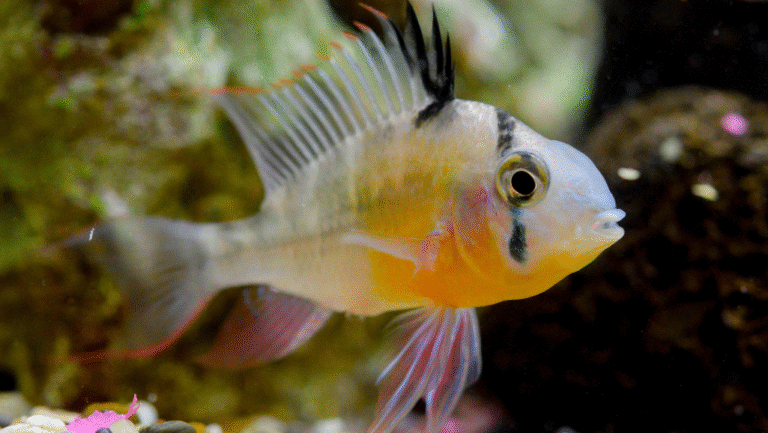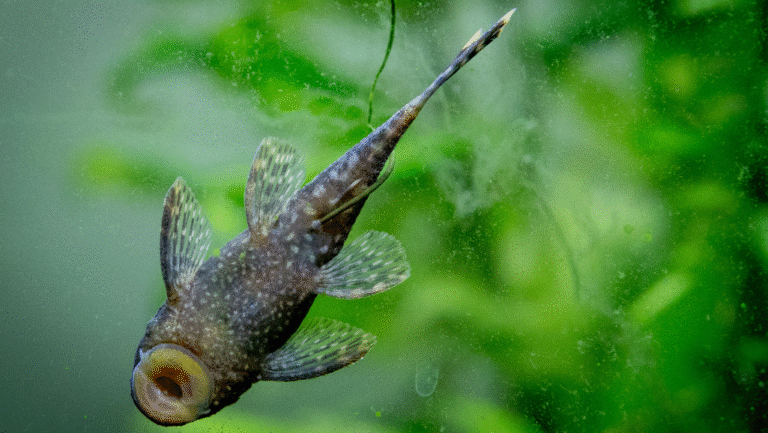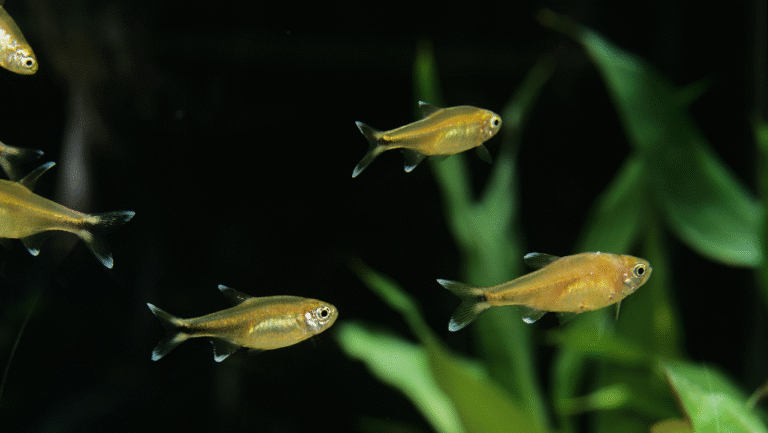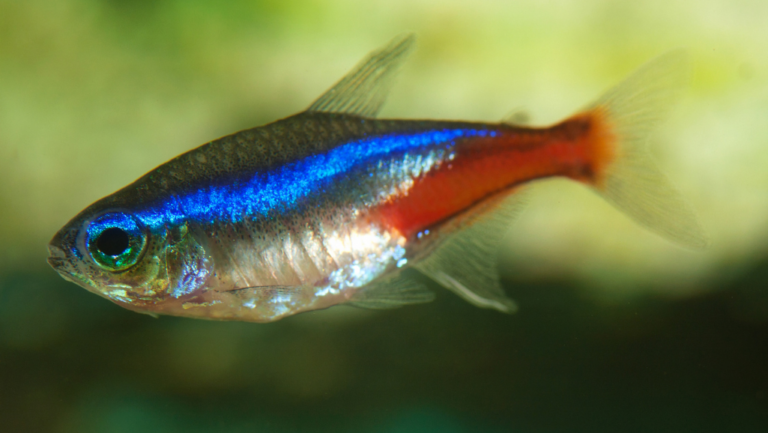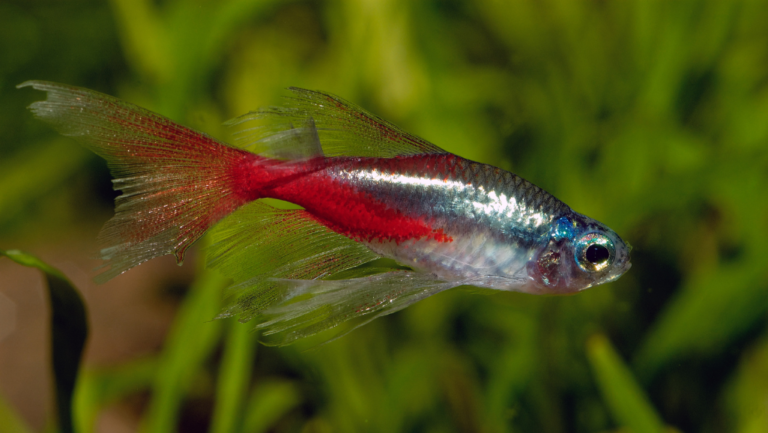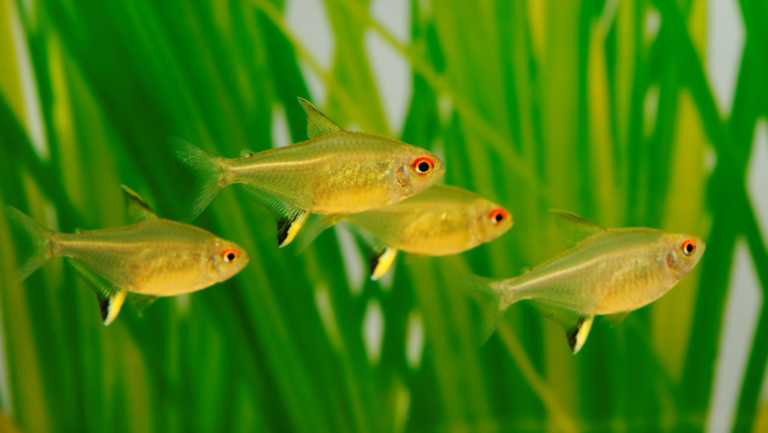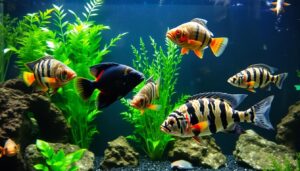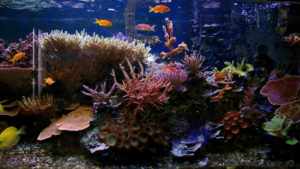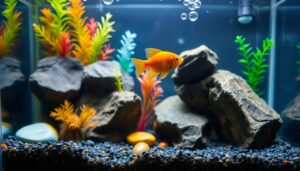Meet the scissortail rasbora, a graceful freshwater fish species that adds shimmer and motion to any home aquarium.
Known by the scientific name Rasbora trilineata, this fish is prized in the trade for its deeply forked “scissor” tail and a striking horizontal stripe. Adults reach about 3.5 inches and live roughly three to five years with proper care.
Native to streams and rivers across Southeast Asia, these rasboras prefer soft, slightly acidic to neutral water in the mid-70s °F. They are peaceful, schooling top-to-mid dwellers and shine in a longer tank with open swimming space.
They adapt to flakes, pellets, frozen foods, and live treats like brine shrimp. With a tight lid, a school of six or more will feel confident and display their best colors in a community setup.
Key Takeaways
- Distinctive forked tail and stripe make this species a visual centerpiece.
- Keep in soft, slightly acidic to neutral water around 72–78°F.
- Minimum 20-gallon long tank with open space highlights schooling behavior.
- Omnivorous diet: flakes, pellets, frozen, and live foods work well.
- Peaceful community fish—maintain groups of six or more for confidence.
Meet the Scissortail Rasbora: Appearance, Size, and Personality
The three-lined rasbora is easy to spot in a community tank. A sleek, silver flank carries a bold horizontal stripe from gill to tail. That stripe highlights a deeply forked fin with yellow, black, and white bands that give the fish its distinctive name.
Signature look and motion
Notice the shimmer—tiny iridescent scales flash under soft light. The scissortail rasbora often opens and closes its tail like tiny scissors while hovering or darting. This scissor motion adds personality whether they are cruising or pausing midwater.
Size, lifespan, and social habits
Adults reach about 3.5 inches, a size that favors open lanes for fast, coordinated swimming. As a peaceful species, these fish thrive in schools; groups reduce stress and boost color. With steady care, expect a lifespan near five years.
- Three-banded tail pattern makes the name memorable.
- Slim build and schooling instincts suit longer tanks.
- Healthy behavior: relaxed schools and smooth, active swimming in the upper two-thirds of the tank.
Planning Your Aquarium: Tank Size, Layout, and Open Swimming Space
Give your scissortail rasbora room to glide: a long, low tank encourages natural, fluid motion and reduces stress. Start with a minimum 20-gallon long aquarium to give these active fish lateral distance for sustained swimming.
Why length beats height: horizontal space lets schools form neat, synchronized lanes. Vertical tanks limit movement and can cause skittishness. If you plan a larger group, size up the tank—more length improves flow, oxygenation, and behavior.
Layout tips for clear lanes
Place plants, driftwood, and rocks around the perimeter to create a river-like corridor down the center. Use low-profile midwater décor so sight lines stay open and schooling stays cohesive.
Substrate, flow, and safety
Choose a darker substrate to make iridescent colors pop and cut glare. Add a gentle to moderate current via filter return or a small powerhead to mimic moving water without buffeting the school.
Secure lids are essential. These top/mid-dwellers can jump when startled, so seal gaps around equipment and use a tight-fitting cover. With the right layout, your rasbora will swim confidently and display their best colors.
- Minimum 20-gallon long tank for lateral swimming.
- Perimeter décor creates open lanes down the center.
- Darker substrate and mild current enhance color and comfort.
- Tight lids prevent escapes and keep the habitat safe.
Water Parameters for Peak Health and Color
Maintain steady aquarium chemistry to bring out the brightest colors and the healthiest behavior in your school. Consistent conditions matter more than chasing exact numbers.
Ideal ranges: aim for a stable temperature in the mid-70s °F (about 72–78°F), a pH leaning slightly acidic to neutral (roughly 6.0–7.5), and soft to moderately hard water around 2–12 dGH. These water parameters mirror the gentle streams where the species thrives and support vivid pigmentation.
Filtration and current
Use reliable biofiltration and moderate flow to keep oxygen high and waste low. A steady, gentle current mimics moving water and encourages natural swimming without stressing the fish.
Peat, tannins, and additives
Consider peat granules or blackwater additives if your tap water is hard or alkaline. Tannins slightly soften water and can deepen color while creating a more natural feel.
Stability and acclimation
Prioritize stability. Most trade specimens adapt well if acclimated slowly. Match source water, add new fish gradually, and avoid sudden shifts in temperature or chemistry.
- Test weekly for ammonia, nitrite, nitrate, pH, GH, and temperature.
- Perform small, regular water changes rather than large, infrequent ones.
- Keep preheated, conditioned water ready to prevent temperature dips during maintenance.
Lighting and Aquascape Ideas that Inspire
Low, diffuse illumination creates a forest-stream mood that highlights horizontal stripes and motion. Use subdued light to let silver flanks flash without overstimulating your school.
Subdued lighting and photoperiod tips for shimmering scales
Set a gentle photoperiod of about 8–10 hours of soft light daily. Dimmable LEDs or floating fixtures diffuse beams and avoid harsh hotspots.
Keep light levels steady to reduce stress and protect water quality by limiting algae bursts.
Java moss and dark substrates to mimic forested streams
Pair a dark substrate with driftwood, smooth rocks, and woven Java moss to recreate leaf-littered riverbeds. These textures draw the eye and spotlight the scissortail rasbora as they glide.
Leave the midwater zone open so schools of fish can flash and turn in unison. Add a modest current to animate plants and create natural movement.
- Use subdued lighting to show iridescence.
- Weave moss into décor for foraging microhabitats.
- Balance contrast and maintenance access for lasting beauty.
Diet and Feeding: From Flakes to Live Foods
What and how you feed these active fish shapes their color, growth, and overall vitality. A steady staple plus occasional protein boosts keeps a school lively and well conditioned.
Balanced staples:
Everyday staples: flakes, micro-pellets, and granules
Build daily meals around high-quality flakes or micro-pellets sized for small mouths. These complete formulas supply vitamins and base nutrition so the school stays healthy.
Color-boosting options: live and frozen treats
Rotate in live foods and frozen fare like brine shrimp, daphnia, and bloodworms to boost color and conditioning. Aim for variety so protein sources stay interesting and natural instincts are satisfied.
Portions, frequency, and clean water
Feed small portions 2–3 times daily that the school can finish in a minute or two. Remove leftovers quickly to protect water quality. Thaw frozen foods and rinse if needed to cut excess phosphates.
- Use feeding rings or target-feed to reduce competition.
- Vary formulas that support color and immunity.
- Watch appetite and body condition weekly for signs of success.
Tip: A thoughtful mix of staples and occasional live foods helps the scissortail rasboras of your tank look and behave their best.
Community Harmony: Compatible Tank Mates and Schooling
A well-chosen mix of calm tankmates brings out the best color and behavior in a schooling group. Healthy community dynamics begin with a peaceful balance of temperament, swim level, and water needs.
Keep a cohesive group of six or more. Adults feel safer in numbers; color deepens and synchronized schools form when anxiety drops.
Choose companions that stay calm and occupy different zones. Good partners include other rasboras, small tetras, danios, gentle gouramis, livebearers, and bottom-dwelling cory catfish. Pick species with similar parameters to simplify care.
- Maintain a group of six+ to boost confidence and color.
- Avoid fin-nippers and oversized predators; they disrupt peace and stress other fish.
- Provide multiple feeding zones and visual breaks so shy fish can retreat without fragmenting the school.
- Scale tank length with school size to preserve open lanes and smooth movement.
Observe interactions at feeding and during lights-on. Minor chasing is normal, but true aggression signals a mismatch that should be corrected quickly to keep the community thriving.
Step-by-Step: Breeding Scissortail Rasboras
Breeding success begins with a calm, dedicated tank that mimics gentle rain-fed streams. Set up a small, separate breeding tank with a sponge filter and low, diffuse light so adults feel secure.
Optimal breeding tank setup
Use spawning mats or fine mesh so adhesive eggs fall through and avoid adults. Keep water slightly acidic (pH 6.0–6.5) and warm—target a temperature of 77–82°F. Minimal lighting and gentle aeration reduce stress and fungus risk.
Conditioning and triggers
Condition males and females for 1–2 weeks on protein-rich live foods like daphnia, bloodworms, and brine shrimp. Encourage spawning by making several small, cool, soft-water changes spaced through the day to simulate passing showers.
Protecting eggs and raising fry
After spawning, remove adults to prevent egg predation. Eggs usually hatch in about 24 hours; fry absorb yolk sacs and become free-swimming in 48–72 hours.
- Keep lighting low and water pristine to prevent fungus.
- Use gentle aeration and consider antifungal measures if needed.
- Begin feeding fry with freshly hatched baby brine shrimp and tiny prepared foods as soon as they swim.
Tip: steady conditions and clean water are the best tools for successful breeding and healthy fry growth.
Health and Care: Prevention, Observation, and Action
Healthy tanks start with regular observation and steady routines that catch problems early. Watch behavior daily so you spot stress signs before disease appears.
Read body language. Clamped fins, flashing, gasping, or hiding can signal trouble. Early action keeps minor issues from spreading through the school.
Spot common infections quickly
Look for salt-like white spots (Ich), ragged fins, or fuzzy patches that suggest fungus. Treat Ich fast with copper-based medicines and isolate the affected fish.
Address fin rot by improving water quality and using targeted antibiotics when needed. For fungal patches, use antifungals and maintain strong aeration.
Quarantine, meds, and water maintenance
Quarantine new arrivals for 2–4 weeks to protect established aquariums. Keep a basic fish medicine kit and follow dosages precisely. Remove carbon during treatment so meds remain effective.
- Schedule consistent, moderate water changes to dilute waste.
- Feed varied, high-quality diets so adults stay resilient.
- Act quickly: isolation plus correct meds stops most outbreaks.
Buying Tips and Acclimation from Store to Home
Choose wisely and bring new stock into your tank with patience. Cautious selection and a slow acclimation routine help fish settle and show their best colors at home.
Selecting healthy, captive-bred stock
Prioritize captive-bred specimens in the trade for better adaptability and sustainability. Ask your local shop about sources and recent tank history.
Pick lively, schooling individuals with clear eyes, intact fins, and even coloration. Avoid fish with white spots or frayed edges.
- Prefer captive-bred stock; it adapts faster to a home tank.
- Look for adults that swim confidently in a group.
- Transport in insulated bags and dim lights on arrival to reduce stress.
Slow acclimation to match water parameters
Match source conditions first. Test the bag water, then your tank water. Plan a slow, drip-style acclimation for 1–2 hours.
Use a gentle drip or float the bag and add small amounts of tank water until temperatures and parameters align.
- Set up a 20-gallon long or larger tank with open lanes and a tight lid.
- Net fish gently into the tank and discard bag water to avoid contaminants.
- Keep lights low on day one, feed lightly, and watch schooling and appetite.
Optional: Quarantine new arrivals first to protect established displays. With careful selection and slow acclimation, your scissortail rasbora will thrive in their new home.
Conclusion
When cared for with steady routines, this elegant fish species rewards aquarists with vivid color and lively motion. Keep a longer tank with open swimming lanes and subdued lighting to highlight the iconic forked tail.
Maintain soft, slightly acidic to neutral water, feed varied foods including occasional live treats like daphnia, and house them in a confident group of six or more. These simple steps boost health and display behavior.
If you try breeding, use a dim, dedicated setup and protect eggs and fry carefully. With the right size, steady care, and thoughtful aquascape, your freshwater aquariums will come alive with the shimmer and grace of scissortail rasbora.
